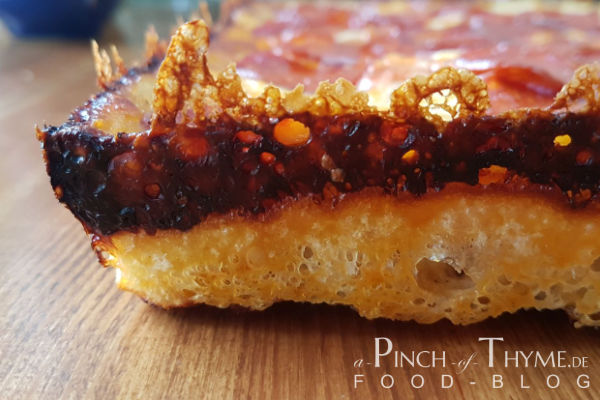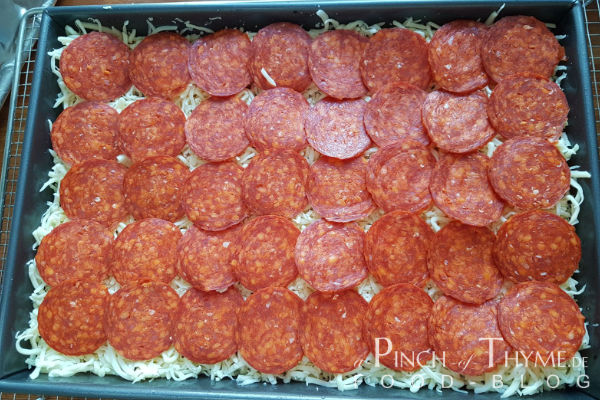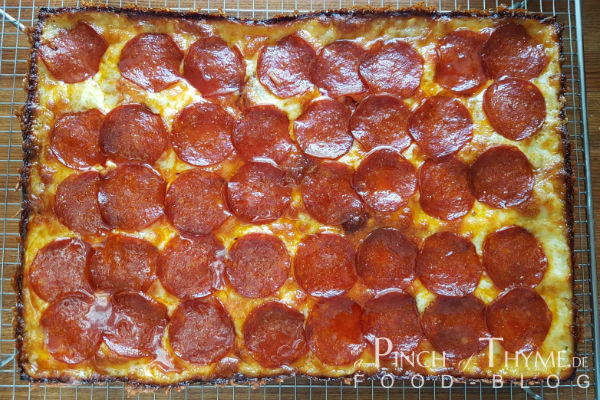Detroit Style Pizza

Motor City’s Culinary Secret: The Detroit Style Pizza
From the vibrant Motown music scene to the impressive automobile industry, Detroit, Michigan, is known for many things. However, one of the most remarkable products of this city is unexpectedly culinary: The Detroit Style Pizza.
Often referred to as “upside down,” Detroit Style Pizza stands out for its unique topping arrangement. Unlike the traditional approach where the sauce is spread on the dough first, followed by cheese and toppings, Detroit Style Pizza reverses this order. First, the toppings are placed on the dough, then the cheese, and finally, the sauce is added – traditionally in two wide strips. It should be noted, however, that not all pizza shops adhere to this.
The Cheese: The Heart of Detroit Style Pizza
Particular attention should be paid to the cheese. Detroit Style Pizza typically uses a blend of mozzarella and Brick Cheese, a mild cheese from Wisconsin known for developing a beautiful, creamy consistency when baked and caramelizing at the edge of the pan. The result is an irresistibly crispy, cheesy crust that wonderfully complements the savory taste of the pizza.
The pizza is baked in rectangular blue steel pans reminiscent of our loaf pans. These pans, originally used in the automotive industry, create the characteristic crispy crust and unique shape of Detroit Style Pizza.
Interestingly, many Detroit locals are surprised to learn that their pizza is a style of its own – they simply know nothing else. But this is precisely what makes Detroit Style Pizza so special. It’s not just a culinary highlight, but also a piece of Detroit’s history and culture.
Detroit Style Pizza: An Undiscovered Gem of the Pizza World
Detroit Style Pizza may not be as famous as its Sicilian or Pizza in Teglia counterparts, but it is in no way inferior. With its unique combination of crispy crust, juicy cheese, and the distinctive “reversed” topping, it’s an impressive masterpiece from Motor City. Every pizza lover should definitely give themselves the chance to try this delicious dish. A unique pizza experience is guaranteed!
Alternative to Brick Cheese
As mentioned above, an authentic Detroit Style Pizza is topped with Wisconsin Brick or a blend of mozzarella and Wisconsin Brick. This is not available in Germany, perhaps only in a specialty cheese shop. Even in the USA, it’s not part of the standard range. After extensive research and several discussions with Detroiters, it turned out that Tilsiter and Butterkäse (literally ‘butter cheese’) come closest in flavor to Wisconsin Brick. Some shops in Detroit, however, only use a blend of mozzarella and cheddar, which I also used for this pizza. But a test with Tilsiter and Butterkäse is still pending.





Ingredients and Preparation
Dough (73% Hydration):
- 300 g Bread Flour
- 220 g Water
- 9 g Salt
- Sugar
- 5 g IDY
Sauce:
- 50% BBQ-Sauce (Mississippi Sweet Apple)
- 50% crushed tomatoes
Cheese:
- 250 g grated Mozzarella
- 50 g Cheddar
- or: Brick Cheese
- First, dissolve the salt, sugar, and yeast completely in the water. Then add the flour and briefly knead with your hands until a homogeneous dough is formed. With one hand, grab the outer part of the dough, pull it towards the center, and press down. Then, turn the bowl 45 to 90 degrees and repeat this step until the dough looks even.
- Next, let the dough rest covered for 30 minutes. Ideally, a damp kitchen towel serves as the cover.
- Then place the dough on the work surface, stretch, and fold. This step is repeated three times at 20-minute intervals. This promotes the formation of a sufficiently strong gluten network. Always cover with a damp kitchen towel between steps; it won’t stick like cling film.
- Now, grease the baking tray generously with rapeseed or soy oil, put the dough in it, and let it rest covered for 15 minutes. Then spread it out flat with your (preferably lightly oiled) hands. At this point, the dough will not reach all corners. No need to panic! After another 30 minutes of rest, the dough will be spread into the corners.
- After an hour of proofing at room temperature, put the covered baking tray in the refrigerator for 12 hours at about 8-10°C (46-50°F). This slows down the yeast process and gives the dough more time to develop flavors.
- If available, place a thick pizza stone in the lower quarter of the oven on a rack. Preheat the oven to 250°C (482°F, top/bottom heat) until the stone reaches a temperature of 230°C (446°F). During this time, the baking tray with the pizza dough can be taken out of the refrigerator and topped. The cheese should be slightly piled up on the edges to achieve a nice caramelized cheese crust.
- As soon as the stone has reached a temperature of 230°C (446°F), slide the pizza into the oven. Then reduce the temperature to 230°C (446°F, top/bottom heat). The pizza stone ensures that the heat remains relatively constant and the base becomes crispy.
- When the cheese has taken on a nice color, cover the pizza with aluminum foil (shiny side up) and bake for a few more minutes.
